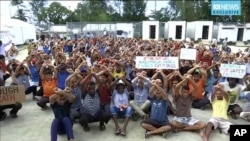A second group of refugees to be resettled in the United States from Australia's offshore immigration centers has left Papua New Guinea. Washington has agreed to take up to 1,250 migrants held in Australian-run processing camps in the South Pacific. In return, Canberra will accept a small number of Central American refugees.
On Tuesday, 58 refugees flew out of Papua New Guinea (PNG), most having been held at the Australian-run detention camp on Manus Island for more than four years. The migrants, mostly from Afghanistan and Pakistan, had been told they would never be allowed to settle in Australia — part of Canberra's long-running policy to combat human trafficking.
Last year, 54 refugees from Australia's two offshore immigration facilities, on Manus Island and the tiny Pacific republic of Nauru, were resettled in the U.S. Another group of 130 refugees on Nauru is expected to leave the island for the U.S. in the coming weeks.
The resettlement deal was brokered between Australia and the Obama administration in 2016, and although derided as "dumb" by U.S. President Donald Trump, it has seen several hundred refugees fly to the United States.In return, Australia will offer a home to a small number of Central American migrants from U.S.-run camps in Costa Rica. So far, about 30 people have reportedly moved to Australia.
Canberra recently rejected an offer made by New Zealand to take 150 of the men being held in Papua New Guinea.
About 2,000 refugees and asylum-seekers remain in Australia's offshore system, including several hundred men who are living in community housing on Manus Island after the Australian camp was officially closed last October.
One of them is Abdul Aziz Muhammad, a refugee from Sudan.
"This morning we had 58 of our friends, our close friends that have we spent so much time with them - and this morning they were so, so lucky that they got on the planes and they are leaving to [the] U.S. and the main question that now we have [is], why only the government want us to go to United States and not New Zealand, because the New Zealand offer is still there on the table? Why cannot the government accept the New Zealand offer to facilitate for all of us?" he said.
Australia's refugee quota has remained steady over the past two decades, with about 13,000 people accepted each year.
Since 2013, asylum-seekers intercepted trying to reach Australia by boat have been sent to migrant camps in the South Pacific. Officials say the policy is meant to deter others from making the same perilous sea crossing, often from Indonesia, where hundreds of people are thought to have drowned over the years.
Critics, though, say Australia's offshore processing program is overly punitive and that detaining asylum-seekers indefinitely has caused great psychological damage.








